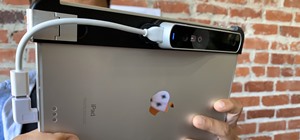When we talk about augmenting our reality, we often first think about vision instead of our other senses—but there's more to an immersive experience than what you see. One inventor figured out how to utilize sound and touch to create a simple, upgraded version of laser tag that you can play with your smartphone.
It's called TZUUM, and here's how it'll work: You stick your phone in an optional "laser gun" attachment (entirely for comfort purposes), plug in your headphones, and meet up with others who want to play. You don't need vests or crazy locations. You can do it anywhere, and your reality becomes augmented through sound rather than sight. The game uses over 30 sounds represented spatially to immerse players in the experience, and players choose teams with orange and blue headbands (though you can, presumably, go with any colors you like).
George Carter III invented this smartphone-based laser tag system (among many other impressive things), but this isn't his first time around the block. He actually invented the very first laser tag game, called Photon, which was at least the basis for the game you know and love—if not exactly what you played in your youth. But a passion for laser tag and a history of building those experiences didn't necessarily lead Carter to create TZUUM. He landed on this idea in sort of an unusual way. The Dallas Morning News explains:
The idea stems from a military project that Carter has been working on for eight years. He has three U.S. patents for systems that create live simulation training for soldiers using common digital camera optics mounted on actual combat rifles that shoot blanks. Smart devices and computers keep score. When the military proved slow on the draw to buy his innovations, Carter switched his focus to a platform for games two years ago. He's used his military patents as steppingstones for a fourth patent and one that's pending that protect key aspects of the game.
With all the tracking technologies in our smartphones, it's not too difficult to track player positions in real-time. In addition to GPS data, Carter's system uses something called geo-pairing, which likely came from all that military work. Everything happens through the phone. You can use the aforementioned laser gun attachment, but it's entirely optional.
Because the vast majority of laser tag games are played by casual players, a cheap and simple system that doesn't require cumbersome equipment or much of a financial investment could engage a lot of new players. More serious gamers can buy the hardware, but anyone with a recent smartphone will be able to play. And if we've learned anything from Pokémon GO, it's that smartphone users are definitely open to augmented reality.
While Carter's laser tag game thrives on its bare-bones approach, it also looks like a great starting point for more complex games in the future. Once we start strapping our phones to our faces with some regularity and use the front-facing cameras for visual augmented reality experiences, Carter's work with 3D audio and geo-pairing could play a major role in how immersive those experiences will become.
If you're interested in TZUUM, Carter is raising money on Kickstarter right now. While they've hit their funding goal, you can still support the project until September 20 and have an opportunity to play first for as little as $10.
Just updated your iPhone? You'll find new features for Podcasts, News, Books, and TV, as well as important security improvements and fresh wallpapers. Find out what's new and changed on your iPhone with the iOS 17.5 update.























Be the First to Comment
Share Your Thoughts